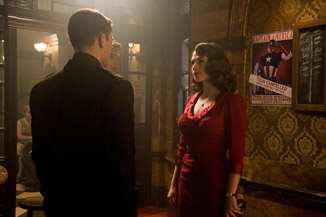|
|
(Comic) Book vs. MovieCaptain AmericaBy Russ BickerstaffJuly 28, 2011
Essentially a 20-page political cartoon supporting US involvement in the war, the first issue of Captain America Comics went on sale about one year prior to the bombing of Pearl Harbor. Released in December of 1940, the debut issue sold nearly one million copies. With an image of Captain America socking Hitler on the jaw, the issue prompted quite a bit of hate mail from those who opposed US involvement in the war. (The issue had a cover date of, “March, 1941,” but the practice of post-dating a comic book cover in the interest of keeping it on the magazine stands longer is a long and distinguished one that goes back many, many years.) Captain America Comics promptly became very successful, regularly selling somewhere around one million copies per issue. (It routinely outsold Time magazine.) Simon and his collaborator Jack Kirby left the series and its publisher for a more financially lucrative career at the company that was to become DC comics, but they left behind the first ten issues of a comic book featuring a character who is still quite popular today. Over 70 years after the character debuted, he is the subject of a major film being released by Paramount pictures. Captain America is a character that first debuted when the US was about to enter a major war in Europe. He is now the subject of a big-budget film being released in an era where popular sentiment is growing against US military involvement beyond Europe. How do those first ten issues of the wildly successful comic book of the 1940s compare with a contemporary big-budget film inspired by them?
[ View other columns by Russ Bickerstaff ]
[ View other Book vs. Movie columns ]
[ Email this column ]
|

|
|
|

|
Friday, November 1, 2024
© 2024 Box Office Prophets, a division of One Of Us, Inc.


